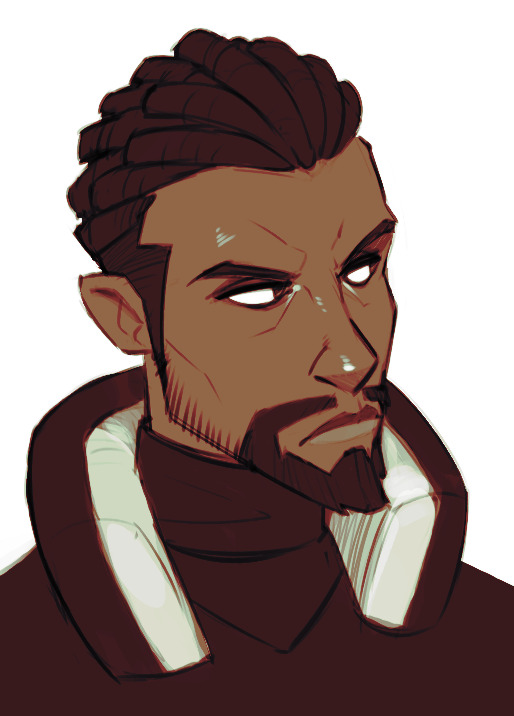#Ekoi
Text


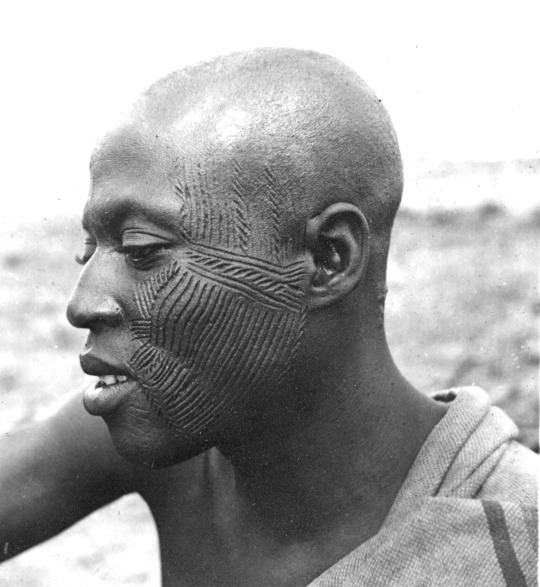
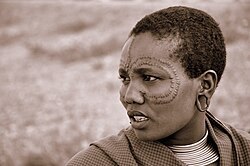
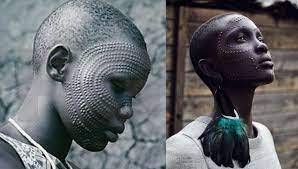
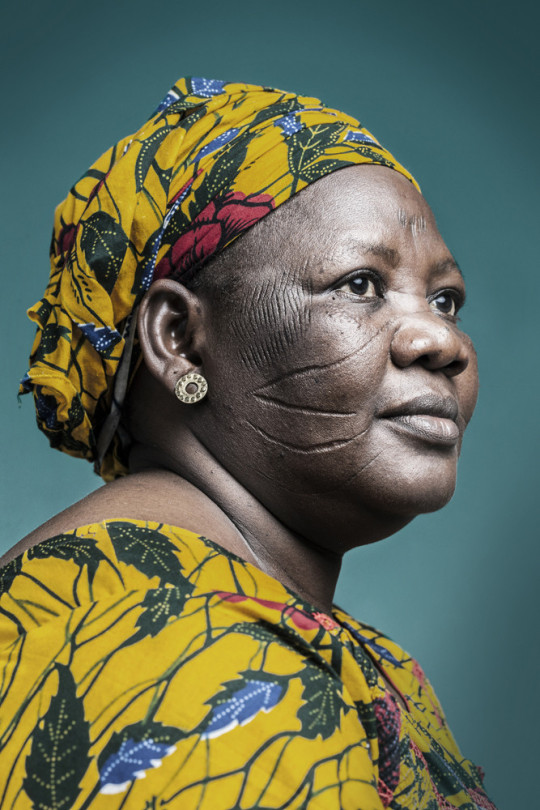
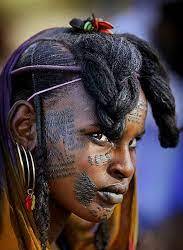

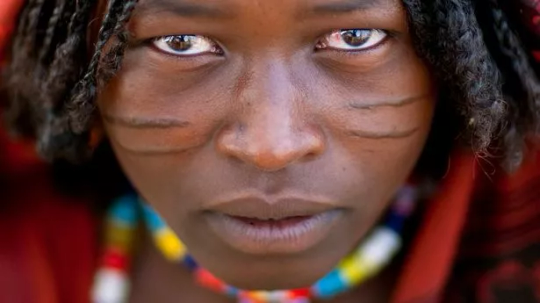
In Africa, European colonial governments and European Christian missionaries criminalized and stigmatized the cultural practices of tattooing and scarification; consequently, the practices underwent decline, ended, or continued to be performed as acts of resistance.
Among the ethnic groups in sub-Saharan Africa that traditionally practice scarification are the Gonja, Dagomba, Frafra, Mamprusi, Nanumba, Bali, Tɔfin, Bobo, Montol, Kofyar, Yoruba, and Tiv people of West Africa, and the Dinka, Nuer, Surma, Shilluk, Toposa, Moru, Bondei, Shambaa, Barabaig, and Maasai people of East Africa.
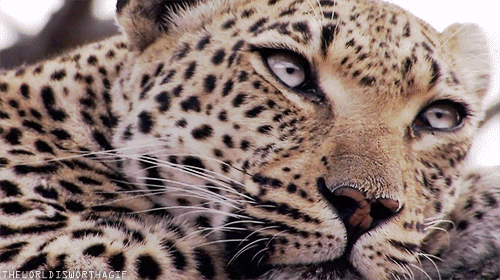
Traditionally, the most common reason for scarification has been as a rite of passage.
Scarification has been widely used by many West African tribes to mark milestone stages in both men and women's lives, such as puberty and marriage.
In many tribes, members unwilling to participate in scarification were generally not included in the group's activities, and are often shunned from their society.
According to anthropologist Grace Harris, group members lacking the normal characteristics consistent with the group are not considered as having acquired the full standing as agents in their society; they would also lack the capacity for meaningful behavior, such as greeting, commanding, and stating.
Therefore, scarification can transform partial tribe members into "normal" members entirely accepted by the group.
Scarification is a form of language not readily expressed, except through extensive and intricate greetings, and gives the ability to communicate fully, which is a key element for being considered as a normal member of the group.

One reason why scarification is used as confirmation of adulthood is how it shows the ability to endure pain. With young men, the endurance of the pain of scarring exhibits strength and discipline, especially in tribes where males have roles as hunters and warriors.
A young man who has already experienced the feeling of torn or cut flesh is considered less likely to fear the teeth of a wild animal or the tip of an enemy's spear.
In Ethiopia and Zambia, elaborate scarification is often done on women at puberty, used to denote a willingness to be a mother. The markings show that she can stand the pain of childbirth, as well as being an indication of her emotional maturity.
Some of these rites of passage have spiritual or religious roots, such young boys in the Chambri tribe of Papua New Guinea undergo scarification resembling crocodile scales to mark their transition into manhood, a ritual which stems from the belief that humans evolved from crocodiles.
In Ethiopia, Suri men scar their bodies to show that they have killed someone from an enemy tribe;
the Mursi practice scarification for largely aesthetic reasons in order to attract the opposite sex and enhance the tactile experience of sex.
The Ekoi of Nigeria believe that the scars serve, on their way to the afterlife, as money.

#ekoi#mursi#maasi#nigerian#scarification#african#afrakan#kemetic dreams#brownskin#brown skin#afrakans#africans#african culture#afrakan spirituality#suri#ethiopian#zambia#afterlife#sacrifice#free will#immortality#philosophy#chambri#rite of passage#tiv#Gonjas#Nanumbas#Dagombas#Frafras#ghana
163 notes
·
View notes
Text
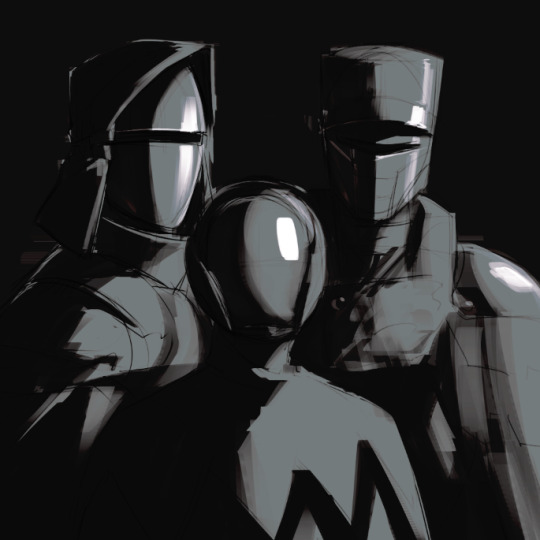
Another Odysseon sketch, guess the album emulation and win nothing.
14 notes
·
View notes
Text
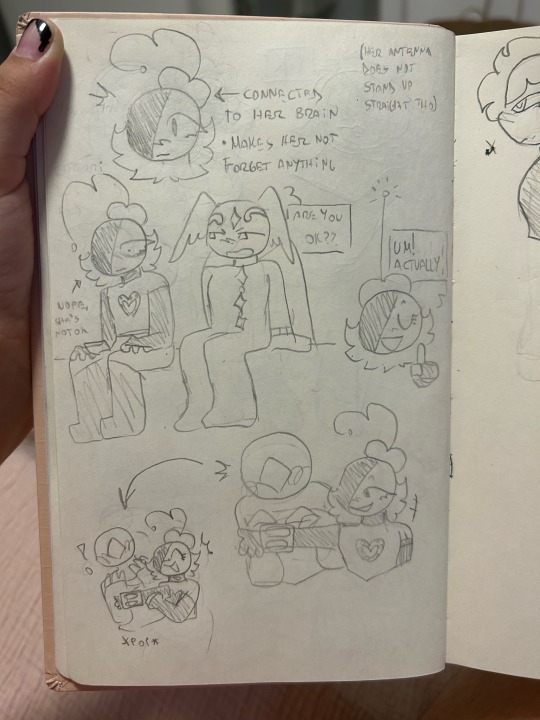
MORREEE Cherri for my friend :D
#IsaArt#Cherri#Ekoi#Tobias#OC#Original Character#stick#stick figure#stickman#stick oc#stick figure oc#stickman oc
13 notes
·
View notes
Text
What is the Ekpe Society?
The Ekpe society, also known as the Leopard Society, is a traditional fraternal secret society found primarily among the Ejaham, Efik, Ibibio, and Igbo peoples of southeastern Nigeria and western Cameroon. This society plays a significant role in the cultural, social, and political life of these communities. The society is known for its elaborate rituals, symbols, and hierarchical structure. The…

View On WordPress
5 notes
·
View notes
Photo

Weekend ride was beautiful. #training #valais #ridevalais #myseitzerland #assos #ekoi #sworks #we_are_sungod #springride #ultracycling @may_philippe https://www.instagram.com/p/CrYzJT_LpDs/?igshid=NGJjMDIxMWI=
2 notes
·
View notes
Text
Sea Otter Coverage - Day 3
Ekoï
Get ready to see more coming from French brand, Ekoï as they push more into the North American market. For Sea Otter, they highlighted their jerseys made with Outlast fabric and their Ultralight and Super Soft bib shorts.
Outlast brings technology developed for NASA to the cycling world. The specially made fabric helps to thermoregulate better, helping reduce perspiration between 30-50% on…

View On WordPress
#Ag2r#Alibi#Arkéa B&B Hôtels#bibs#Big Bore#Bike Clean#Bike Wash#brake pads#Breakaway+#BTI#Ceramic Bike#Continental#Decathlon#Deda#Dogma XC#Drivetrain Degreaser#DuraPrint#Ekoi#filter#Freewheel#Grilamid#Gtechniq#helmet#HydraPak#INEOS Grenadiers#Israel Premier Tech#jersey#KOO#Lens#MHS
0 notes
Text
Les ventes privées Ekoi sont de retour
Les ventes privées Ekoi sont de retour. N’attendez pas pour en profiter
Cliquez ici pour en profiter

View On WordPress
0 notes
Video
Cómo son los PRODUCTOS EKOI y mi experiencia | UNBOXING | EKOÏ
0 notes
Photo

Such a cool graphic of the Yowamushi cycling team partnering with Ekoi for their racing kits #yowamushipedal #ekoi #yowamushi #yowamushi_pedal #ekoicycling (at KDT Optometry) https://www.instagram.com/p/ClhI5_PSb42/?igshid=NGJjMDIxMWI=
0 notes
Photo
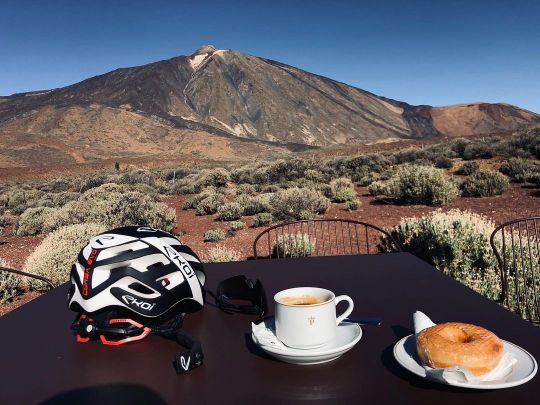
Esto es una experiencia única, deportiva y fotográfica. Vamos a subir en bicicleta de carretera desde el nivel del mar hasta el Parador del Teide por las carreteras donde entrenan los profesionales a 2100m de altitud. En el camino te haré fotos en las curvas más bonitas y con mejores vistas panorámicas, pasando por espectaculares miradores. Una vez en el Parador del Teide tomaremos un café y un dulce con vista al volcán para luego volver a nivel del mar después de más de 100km de recorrido. Enlace en la bio. #cycling #ridesolo #cyclinglife #cyclisme #cyclingcoffee #coffee #teide #teidenationalpark #volcano #cyclingphotos #cyclingpassion #cyclinglifestyle #ekoi #parador #landscape #landscapephotography #coffeeride #coffeelover #neverstopcycling #ekoicycling (en Parador de Cañadas del Teide) https://www.instagram.com/p/CIqPtLfF1pz/?igshid=NGJjMDIxMWI=
#cycling#ridesolo#cyclinglife#cyclisme#cyclingcoffee#coffee#teide#teidenationalpark#volcano#cyclingphotos#cyclingpassion#cyclinglifestyle#ekoi#parador#landscape#landscapephotography#coffeeride#coffeelover#neverstopcycling#ekoicycling
1 note
·
View note
Text
Veste coupe-vent thermique Ekoi Polartec
Veste coupe-vent thermique Ekoi Polartec
Pas vraiment de saison mais si la météo est mauvaise cet été, cette veste coupe-vent Ekoi Polartec pourra toujours vous être utile ! Avant de devenir indispensable l’automne et l’hiver prochain…
Pour la première fois, Ekoi fait appel à Polartec pour fabriquer un vêtement. La veste coupe-vent thermique Ekoi Polartec développée avec l’équipe Arkea-Samsic, utilise ainsi des inserts en Polartec…

View On WordPress
0 notes
Text
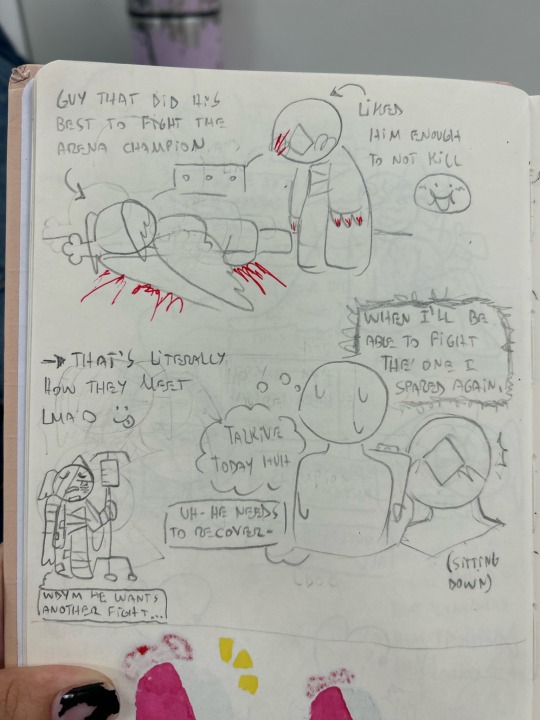
I always make ‘em being sweet over each other, I really should make more drawings of these mfs pre friendship
#IsaArt#it’s something like-#Tobias FINALLY gets a good fight#(not killing his opponent in one shot)#and he gets EXTREMELY interested on Ekoi#that’s how it starts#cuz Ekoi just shitting his pants for now#Tobias#Ekoi#Oc#original character#stick#stick figure#stickman#stick figure oc#stickman oc#stick oc
8 notes
·
View notes
Text
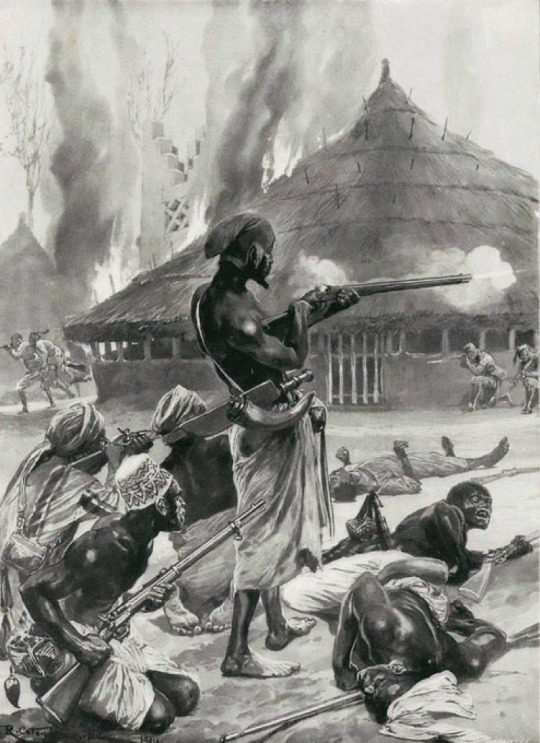
Aro Confederacy
The Aro Confederacy (1690–1902) was a political union orchestrated by the Aro people, Igbo subgroup, centered in Arochukwu in present-day southeastern Nigeria. The Aro Confederacy kingdom was founded after the beginning of the Aro-Ibibio Wars. Their influence and presence was all over Eastern Nigeria, lower Middle Belt, and parts of present-day Cameroon and Equatorial Guinea during the 18th and 19th centuries. The Arochukwu Kingdom was an economic, political, and an oracular center as it was home of the Ibini Ukpabi oracle, High Priests, the Aro King Eze Aro, and central council (Okpankpo). The Aro Confederacy was a powerful and influential political and economic alliance of various Igbo-speaking communities in southeastern Nigeria. It emerged during the 17th century and played a significant role in the region until the late 19th century.
The exact origins of the Aro Confederacy are not precisely documented, but it is believed to have been established around the mid-17th century. The Aro people, who were part of the Igbo ethnic group, inhabited the region around present-day Arochukwu in Abia State, Nigeria. They were skilled traders and missionaries who played a pivotal role in connecting various Igbo communities. This migration and their military power, and wars with neighboring kingdoms like supported by their alliances with several related neighboring Igbo and eastern Cross River militarized states (particularly Ohafia, Edda, Abam, Abiriba, Afikpo, Ekoi, Bahumono, Amasiri etc.), quickly established the Aro Confederacy as a regional economic power. The Aro Confederacy's strength came from its well-organized network of Aro agents who were dispersed across different communities in the region. These agents acted as intermediaries in trade, diplomacy, and religious matters. They facilitated commerce, resolved disputes, and spread the worship of the Aro deity known as the "Long Juju" oracle."The Opening Up of Nigeria, the Expedition Against the Aros by Richard Caton Woodville II" 1901
The "Long Juju" oracle was the spiritual centerpiece of the Aro Confederacy. It was housed in Arochukwu and considered a potent source of political authority and religious guidance. The Aro people used the oracle to enforce their influence and control over surrounding communities. It also served as a means to administer justice and settle disputes, often attracting pilgrims seeking solutions to their problems.
The Aro Confederacy gained significant economic power through trade and commerce Their economy was primarily based on agriculture, with the cultivation of crops like palm oil, yams, and cassava. They were also involved in trade with neighboring communities and European merchants. They controlled trade routes that passed through their territories, collecting tolls and taxes from traders. The Aro also engaged in the Trans-Atlantic slave trade by capturing and selling slaves to European traders.
Aro activities on the coast helped the growth of city-states in the Niger Delta, and these city states became important centres for the export of palm oil and slaves. Such city-states included Opobo, Bonny, Nembe, Calabar, as well as other slave trading city-states controlled by the Ijaw, Efik, and Igbo. The Aros formed a strong trading network, colonies, and incorporated hundreds of communities that formed into powerful kingdoms. The Ajalli, Arondizuogu, Ndikelionwu, and Igbene Kingdoms were some of the most powerful Aro states in the Confederacy after Arochukwu. Some were founded and named after commanders and chiefs like Izuogu Mgbokpo and Iheme who led Aro/Abam forces to conquer Ikpa Ora and founded Arondizuogu. Later Aro commanders such as Okoro Idozuka (also of Arondizuogu) expanded the state's borders through warfare at the start of the 19th century. Aro migrations also played a large role in the expansion of Ozizza, Afikpo, Amasiri, Izombe, and many other city-states. For example, Aro soldiers founded at least three villages in Ozizza. The Aro Confederacy's power, however, derived mostly from its economic and religious position. With European colonists on their way at the end of the 19th century, things changed.Burning of Arochukwu 1901
During the 1890s, the Royal Niger Company of Britain bore friction with the Aros because of their economic dominance. The Aro resisted British penetration in the hinterland because their economic and religious influence was being threatened. The Aro and their allies launched offensives against British allies in Igboland and Ibibioland. After failed negotiations, the British attempted to conquer the Aro Confederacy in 1899. By 1901, the tensions were especially intensified when British prepared for the Aro Expedition. The invasion of Obegu (in Igboland) was the last major Aro offensive before the start of the Anglo-Aro War. In November 1901, the British launched the Aro Expedition and after strong Aro resistance, Arochukwu was captured on December 28, 1901. By early 1902, the war was over, and the Aro Confederacy collapsed. Contrary to the belief that the Ibini Ukpabi was destroyed, the shrine still exists, and is intact in Arochukwu and serves mainly as a tourist site.

#african#afrakan#kemetic dreams#africans#afrakans#brown skin#brownskin#african culture#afrakan spirituality#arochukwu#anglo aro war#obegu#igboland#ibibioland#igbo#igbo culture#british#long juju#aro confederacy#confederacy#nigerian#cameroon
26 notes
·
View notes
Photo

Bike mode = Beast mode. First outdoor road bike ride of the season. It was a bit cold and wet, but that’s good training for Poland 🇵🇱 #ultracycling #ucwc #sworks #ekoi #myspecialized #we_are_sungod #trainingride https://www.instagram.com/p/CrIM7Afu5PY/?igshid=NGJjMDIxMWI=
0 notes
Text
Ekoï R4 Light - Blending Light, Stiff, and Airy Into a Summer Shoe
Cycling shoes are an essential part of our equipment. With them, we lock our feet into clipless pedals and use their efficiency to push and pull, helping us transfer power. We want them to be light like everything else, stiff to transfer power efficiently, and breathable to help keep our feet cool. The Ekoï R4 Light isn’t perfect in every category but does well to find a balance that will work…
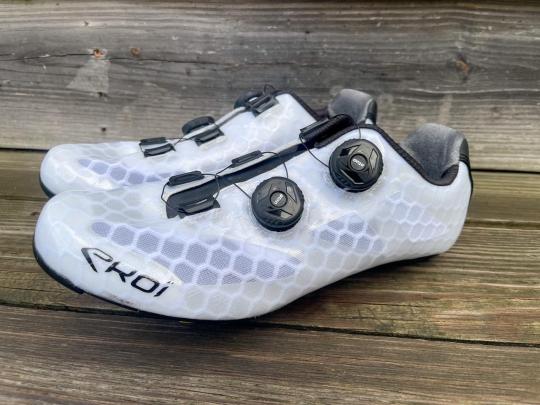
View On WordPress
#AR14#Atop#black#breathability#breathable#carbon#cycling#Ekoi#Felt#food#French#helmet#light#Lightweight#Look#nylon#OPEN#power#R4 Light#racing#review#road#running#saddle#shoe#shoes#Sole#stiff#summer#sunglasses
0 notes
